Abstract
Karst systems consist of heterogeneous aquifers characterized by non-linear hydrogeological behavior. This is intrinsically linked to the coexistence of saturated versus unsaturated, open-channel versus closed-conduit flow and laminar versus turbulent flows within these aquifers. These multiple dualities together with a lack of knowledge of their internal structure lead to increasing difficulties in the management of groundwater resources related to karst aquifers. However, karst aquifers constitute strategic fresh water resources and many stakeholders carry out withdrawals sometimes continuously or centered on the period of low water level as for the irrigation. These withdrawals generate discharge decreases that can constitute sources of conflicts between upstream and downstream users of the resource. In this study, we propose a methodology to assess the impact of withdrawals on the spring discharge of a karst aquifer based on a conceptual non-linear reservoirs model. This methodology is applied to the second largest karst system in France: The Touvre karst system (La Rochefoucauld). The simulated influence of the total withdrawals on runoff deficit is larger than the total withdrawals in relationship with the non-linearity of the conceptual models. Globally, this impact is about one and a half of the total withdrawal depending of the year under consideration. Moreover, we show that it also implies a decrease from 10% to 20% of the low-flow annual discharge. The next step will be to also address the issues raised by the climate change projections.
1. Introduction
The supply and protection of water resources has now become a major concern and constitutes a decisive challenge for the next decade in a context of increasing world population and global change. Climate change and increasing anthropogenic pressure on freshwater resources are prompting us to propose management plans that take all parameters into account. Among the different stocks available and present on a large part of the globe, karst aquifers constitute heterogeneous hydro-systems that are extremely sensitive to recent changes and whose sustainable exploitation constitutes a major challenge for water managers. On a global scale, 20% of the entire population depends on these reservoirs for their water supply [1].
In France, karst aquifers are present on a large part of the territory with around 35% of its surface made of carbonate outcrops [2,3]. They contribute up to 40% of the drinking water supply. Karst systems develop in carbonate rocks, as well as in soluble rocks such as evaporites. A set of complex evolutionary processes, combining physico-chemical and mechanical alterations, widen the initial voids of the surrounding rock and progressively establish a drainage structure organized along preferential flow paths along geological discontinuities, such as fractures and faults. These dissolution processes may take place under the combined effect of infiltration of meteoric water and of the ascent of deep hydrothermal fluids. The major difficulty in understanding the functioning of karst aquifers lies in understanding the heterogeneity of these structures and their consequences on water flow processes, especially on low flow dynamics [4].
Facing such complexity and diversity of organization and operation, it is often difficult to propose a sustainable water resource management policy, particularly when many stakeholders depend on this resource in a given area [5,6,7]. Among previous contributions, Hartman et al. [8] propose a comparison of climate change and withdrawals influence on the Faria spring discharge in Naplouse. They show that non-controlled groundwater abstraction plans can lead to spring dry up that would not occur under climate change alone. This study thus highlights the need for a good assessment of groundwater abstraction impacts to avoid such consequences on karst springs.
In order to quantify the impact of anthropogenic pressures, we propose here a new parsimonious methodology for reconstituting natural spring discharge, which consists of estimating the temporal variations in discharge uninfluenced by withdrawals. Such a reconstitution thus makes it possible to estimate the hydrological regime of the catchment area in the absence of anthropic withdrawal on the water resources. We propose a conceptual-based approach since in many cases there is a lack of available data on karst watersheds, especially concerning the spatialization of the karstified network. In these cases, classical numerical approaches used in porous or fissured aquifers cannot be easily implemented.
It is important to note another limitation of our approach: Other anthropogenic actions such as land cover land use (LCLU) changes in term of agricultural rotations, for example, or climate change impacts on hydroclimatic conditions are not, for the moment, considered in our approach. However, we acknowledge that systematic analysis of karst spring discharge constitutes another valuable field of investigation in order to highlight trends over annual minimum discharge variations [9].
The modelling proposed here assesses the impact of withdrawals on the volumes available at the outlet, but also on characteristic indices of the system functioning during low-water periods. Our aim is to propose a general method for assessing the impact of withdrawals on a karst system using a conceptual model with non-linear reservoirs representing the main karst groundwater flow processes.
The proposed methodology can be divided into four steps:
- Building a hydrological model appropriate to the karstic system, integrating rainfall, evapotranspiration and surface input data via potential losses, and above all integrating withdrawals and discharges (of agricultural, industrial or domestic origin);
- Estimating parameters of the hydrogeological model based on the available data for model calibration;
- Proposing a new simulation of discharge over the period under consideration with the removal of abstractions;
- Comparison of time series and estimation of the impact of abstractions on low water discharge.
We propose an application of this methodology to the large French karstic system of the Touvre, which brings together problems of understanding the physics of flows linked to karstic specificities, as well as problems linked to the anthropogenic pressures with various water users on the catchment area. The springs of the Touvre constitute the second largest karstic resurgence in France after the Fontaine du Vaucluse in terms of mean annual discharge. Given its major role in the security of the drinking water supply, the karstic system of the Touvre constitutes a strategic water resource of regional interest. In fact, since 1889 Angoulême city relies completely on the karst Touvre spring to provide drinking-water supply to a population of around 110,000 habitants. This resource is also used today by various others stakeholders, notably agricultural and industrial, and the impact of these withdrawals on the discharge, and in particular the low water discharge at the system’s outlet, is the subject of a debate between the user in the upstream and downstream part of the system.
2. Materials and Methods
2.1. Lumped Parameter Modeling
Given the lack of spatial information on the structure of the karst reservoir, we propose a conceptual non-linear reservoir model. This model allows the simulation of flows in a karst environment while considering surface infiltrations and withdrawals from the different compartments of the watershed
We aim to propose a hydrogeological model based on the KarstMod modeling platform [10], which can be modulated to simulate discharge at the outlet and to quantify the internal flows between the different compartments of the model and can be applied on various karst catchments [11,12,13,14]. KarstMod is developed by the Service National d’Observation du Karst (SNO Karst—INSU/CNRS). The proposed model comprises three compartments organized in two levels. The upper level corresponds to reservoir E (Epikarst). It represents the unsaturated part of the system, which is also the location of a transient aquifer. This reservoir is connected with the two reservoirs of the lower level: C (Conduit) and M (Matrix). The C conduit reservoir corresponds to the flows in the main karst conduits of the system and more generally to the rapid flows observed in parts of the system with higher hydraulic conductivity. Reservoir M (matrix) accounts for flows in the fractured environments of the system, albeit in relation to the conduits. However, the flows here are slower. Reservoir E controls the recharge of the system and so is subject to both precipitation and evapotranspiration. Reservoirs M and C are in connection with reservoir E and may be subject to external forcing such as pumping (groundwater abstraction) or injections (river losses).
From a general point of view and in application of the laws of conservation of mass, the model is characterized by the following differential system to be solved at each time step:
with E, M and C (L) water levels in reservoirs E, M and C, respectively, P (L T−1): Precipitation rate, ET (L T−1): Evapotranspiration rate, , (L T−1): Withdrawals from reservoirs M and C respectively, per unit area and finally , , , , (L T−1): Internal flow rates per unit area, (): Catchment area, Qs (L3.T−1): Watershed outlet flow.
In general, for a given reservoir A (and therefore characterized by a level also noted as A in mm) and its outlet noted as S, the non-linear head loss law is expressed as follows:
where (L T−1) is the pressure drop coefficient between the two reservoirs, A (L) is the water level in the reservoir, and is an exponent that introduces a potential non-linearity in the model. Finally, we propose to introduce a flow between the conduit and the matrix (which can be positive if the flow is from reservoir M to reservoir C and it can be negative if the flow is from reservoir C to reservoir M). This flow integrates the interactions observed physically between these two compartments, which are particularly important during floods or during low water support [12,15]. Here, this internal flow noted is expressed by the following expression:
where (L T−1) is pressure drop coefficient between the two reservoirs, M and C (L) are the respective water levels in reservoir M and reservoir C and is an exponent that introduces a potential non-linearity of the model.
2.2. The Touvre Karst System
The Touvre karst system consists of a binary system (Figure 1). The infiltration consists of a delayed infiltration of effective rainfall on the karstic recharge area, but also of direct infiltration of surface water of the Tardoire, Bandiat and Bonnieure rivers [16,17].
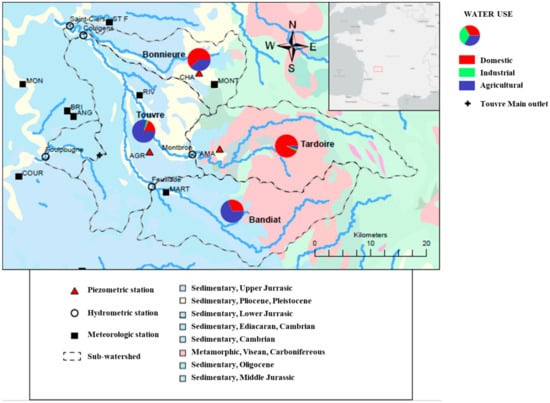
Figure 1.
Localisation of the Touvre karst aquifer and of the main hydrological, piezometric and meteorological stations. The percentages of different use of water over the four main sub-catchments (Touvre, Bandiat, Bonnieure and Tardoire) are also mentioned (stations’ acronyms: AGR: Agris, AMA: Amant, ANG: Angoulème-Brie-Champoniers, BRI: Brie, CHA: Chazelles, COUR: La Couronne, MART: Marthon, MON: Montignac, MONT: Montembœuf, RIV: Rivières and STF: Saint-Front).
All the geological formations of the massif to the east of the Bajocian to Kimmeridgian springs are likely to develop karst networks. Moreover, the aquifer is well delineated geologically with a base corresponding to the impermeable marls of the Toarcian-Alenian and with a roof outcropping or sub-outcropping under the Quaternary alluvial formations, an Tertiary or Secondary (Cenomanian) continental detritic formations. While the karst is well described in its superficial part, it is almost unknown in its deep parts, even with deep drilling between 200 and 300 m that has revealed transmissive networks.
The limestone massif constituting the aquifer is well delimited. The eastern limit corresponds to the transition from the Toarcian-Alenian marl to the Bajocian limestone. The western boundary corresponds to the limit of the Upper Jurassic reef facies beyond which the formations become marlier, and therefore less likely to develop karstic networks. To the south-west, the limit corresponds to the Echelle fault. The northern and southern limits correspond to piezometric ridges.
The springs of the Touvre have three main outlets (the Bouillant, the Dormant and the Font de Lussac) and a secondary outlet (the Lèche) which is located at about 500 m from the first. They drain a massif of limestone of the Middle and Upper Jurassic, which extends from the northeast to the southeast of the emergences on the margins of the Massif Central. These outlets are located 7 km east of Angoulême.
The Bandiat and the Tardoire rivers have their source outside the sedimentary zone on impermeable crystalline terrain in the Massif Central. As soon as the rivers leave the impermeable terrain and enter the fractured limestone regions, losses occur. At present, the water infiltration occurs to such a degree that the waters of the two rivers are lost in their entirety for up to nine months a year. The Tardoire only joins the Charente river in periods of high water. The losses start at Feuillade on the Bandiat and at Montbron on the Tardoire.
The influence of the Bonnieure is less clear. In fact, in high water conditions, a piezometric peak can be observed between the Bonnieure and the Touvre watershed, probably reflecting the contribution of water from the surface water table contained in the sandy-clay formations. At low water, however, this ridge no longer exists. During these periods, there is probably a process of feeding the karst water table by the Bonnieure. Previous artificial tracing operations did not clearly demonstrate any relationship of the waters of the Bonnieure to the north with the sources of the Touvre, but this connection still seems a reliable hypothesis.
The Touvre watershed has been the subject of studies aimed at understanding its functioning. Larocque et al. [18] proposed a systematic study using the tools of correlative and spectral analysis of the various hydrological, climatic and hydrogeochemical signals available in the study area. This analysis highlighted the strong hydraulic spatial heterogeneity of the La Rochefoucauld karst system. The La Rochefoucauld karst system highlights a relatively low level of karstification with a high regulation time of around 75 days.
The model presented by Le Moine et al. [19] was not specifically designed for a karst watershed but aimed to consider potential losses to other catchments in the GR4J models. In particular, the authors applied this model to consider karst losses from the Bandiat and Tardoire catchments into the Touvre karst system. In addition, an extension of the study proposed a non-linear reservoir model of the Touvre integrating these losses as input. The results are encouraging, but the influence of withdrawals on low-water discharge in particular could not be quantified.
A neural network approach developed by Kurtulus and Razack [20] for the period 1980–1986 made it possible to propose an original non-linear simulation of measure discharge based on precipitation and potential evapotranspiration data. However, beyond the learning phase of the artificial neural networks model, the prediction phases of the model indicated a degradation of the correlation between measured and simulated discharge, in particular for low discharge. However, this approach did not make it possible to quantify the impact of withdrawals on the watershed. Finally, Laroque et al. [21,22] also proposed a distributed numerical modelling approach for this watershed by exploring the transient aspects in particular.
Therefore, the Touvre watershed does not currently have a predictive model over long periods integrating a predominant karstic component between the different components of the massif and allowing the consideration of the withdrawals taking place on the whole of the karstic and non-karst impluvium of the watershed. This contribution aims to provide a first order estimation of the impact of the withdrawals based on a conceptual model in order to provide a first estimation to all the stakeholders of water supply over the region.
2.3. Data
According to long-term weekly measurements made by a hydrological station at Ruelle (within 1 km from Touvre resurgence) between 1895 and 1996, the minimum interannual weekly discharge is 1.4 m3/s, the average interannual discharge is 11.1 m3/s and the maximum interannual discharge is 40 m3/s. In order to properly address this issue, the daily time step is the most appropriate. In the context of this study, we relied on daily data measured a little upstream from the Touvre resurgence at Foulpougne.
The Touvre station at Foulpougne resurgence has been monitored since 1980. In addition, to consider the infiltrations on the karstic impluvium, we used the daily discharge data measured at the stations of Montbron for the Tardoire, Feuillade for the Bandiat and Saint Ciers for the Bonnieure, also extracted from the HYDRO database (http://www.hydro.eaufrance.fr/ from 1 January 2016 up to 31 December 2018). Finally, in order to be able to estimate the losses of the Bandiat and the Tardoire during their passage on the limestone impluvium, the daily discharge data measured at the Coulgens station were introduced into the model. Indeed, the discharges measured at Coulgens are characterized during the summer period by a total drying up and therefore an infiltration of the rivers in the karst. During the high-water period, the infiltration via the losses is also active and the discharge increases at Coulgens station.
In order to estimate the effective rainfall, an estimation of daily rainfall was carried out based on rainfall records of up to eight meteorological stations managed by Meteo-France (Figure 1). However, during the study period, daily rainfall data were not available for the whole period 2006–2018 and we therefore proposed an estimation with Thiessen polygons of variable size. A statistical analysis showed that this estimation did not lead to any change in the mean or variance of the series. For the estimation of daily ETP, we used Oudin’s formula [23] for the available periods and then applied the Thiessen polygon method. As cultivated fields represent 25% of the watershed and local agriculture is mainly based on the culture of corn, a cultural coefficient of 1.1 was applied to produce an estimate of daily AET over the period from the 1st of June up to the 15th of September [24]. Again, statistical analysis showed that this estimation with a variable number of stations did not lead to any change in the mean or variance of the series.
Concerning the estimation of anthropogenic abstractions, the annual abstraction data on the Touvre catchment area and the three other surface catchment areas, covering the period 2006–2018, were provided by the Adour Garonne Water Agency. In 2015, there were more than 175 declared abstraction points in all four watersheds (including 84 in the karstic impluvium of the Touvre). In the Touvre watershed, 4.6 Mm3 of water were withdrawn for agricultural needs and 1.1 Mm3 for domestic drinking water needs, mainly via boreholes. In the other three watersheds, 2.5 Mm3 were withdrawn for agricultural needs and 3.29 Mm3 for domestic drinking water needs, mainly via river intakes or alluvial groundwater drilling.
The total annual withdrawals on the watershed roughly correspond to 5% of the total water available at the outlet of the aquifer. This is quite low compared to the 50% of annual withdrawals considering the Lez spring for Montpellier city water supply [25] but comparable with the 15% of annual withdrawals put in evidence by Sivelle et al. [26] considering the Oeillal karst aquifer used for Narbonne city water supply.
At first glance, the 20 Mm3 of annual withdrawals may seem minimal compared to the 400 Mm3 supplied by the springs. However, these withdrawals are essentially concentrated in the summer months, when the flow of the springs is also low. Focusing on these three summer months, these withdrawals correspond to approximately 11.5 Mm3 for a volume of 50 Mm3. The main question is to evaluate the influence of these withdrawals on the flows available at the watershed outlet downstream where a strong conchicolous activity is present.
The application of the parsimonious model leads to several hypotheses concerning the daily internal forcing and in order to make both direct infiltration from surface rivers and groundwater abstractions. The daily internal forcing includes here the daily agricultural, industrial and domestic withdrawals from the conduit but also part of the discharge of the Bandiat and Tardoire rivers, which are located at the level of the contacts with the limestones of the Touvre watershed. With regard to the estimation of daily infiltration from the Bandiat and Tardoire rivers, field observation at Coulgens led us to propose an infiltration rate towards the conduit reservoir of 90% and an infiltration rate towards the matrix reservoir set at 10% on a permanent basis.
With regard to withdrawals, it was necessary at this stage to propose a model for the distribution of annual agricultural withdrawals on a monthly and then daily basis [27]. It was necessary to specify over such a vast area, the level of abstraction on the scale of a catchment area as the accumulation of numerous individual decisions by each irrigator. We make the hypothesis that the agronomic optimum corresponds to irrigation management at the MTE (maximum evapotranspiration). The MTE is determined by the crop coefficient which evolves according to the development stage of the crop: MTE = crop coefficient × PTE. Following Allen et al. [24], we set the crop coefficient at 1.1 for the period from June up to mid-September and its variation is assumed constant from one year to the next one. Irrigation is supposed to provide the plants with water to complement the rainfall and the soil reserves. Thus, the theoretical monthly water demand of the crop is evaluated by agro-climatic zone using a water balance on the RFU fixed at 60 mm. Water supply by irrigation is capped at 5 mm/day in relation to the available agricultural equipment. Daily withdrawals are estimated by dividing by the number of days in the month making the hypothesis of an overall stationarity of irrigation at the daily scale during low water periods. With regard to domestic and industrial withdrawals, daily withdrawals are simply taken as a uniform distribution of the annual withdrawal because no indication of under or over consumption has been detected in this watershed.
To quantify the rapid infiltrations in the model, we relied again on experimental field data, namely the artificial tracings carried out in the watershed at the level of the Bandiat and Tardoire losses. The various tracings carried out made it possible to highlight different transit times in high and low water. The speeds measured vary from 50 to 100 m/h depending on the place and time of injection, from 50 to 60 m/h in low water periods and from 100 to 120 m/h in high water periods (i.e., an overall transfer time of five to 10 days). From the estimated residence time distribution functions on these tracings, we have proposed infiltration transfer functions for the periods of high and low water. In the high-water phase from November to May, the transfer function includes a delay of five days and the sampling is then distributed over the four following days following a weighting {0.1, 0.2, 0.4, 0.2, 0.1}. In the low water phase from June to October, the transfer function includes a delay of 10 days and the sample is then distributed over the next four days using a weighting {0.5, 0.3, 0.15, 0.05}.
The daily internal forcing includes the daily agricultural, industrial and domestic withdrawals from the matrix reservoir and a term corresponding to a potential diffuse infiltration of the Bonnieure river located to the north of the Touvre system. As far as the withdrawals are concerned, it is clear that the influence is not immediate for the system and even slower and more diffuse than for the conduits. While the injection points of the tracings do not allow us to deduce a clear connection between the Bonnieure and the Touvre, we have estimated, in view of the work of Laroque et al. [18] in particular, that a supply to the karstic system of the Touvre was possible. In order not to add parameters and on the basis of the transmissivities estimated by Laroque et al. [21], we therefore proposed to include a transfer function including a delay of 10 days followed by a constant infiltration over 10 days. In order not to overcomplicate the model, this transfer function was also applied to the withdrawals identified on the matrix reservoir.
Classically, the calibration criterion chosen in hydrological modelling is the Nash coefficient [28], which corresponds to the mean square deviation between observed and simulated discharge. We tried many calibration criteria available in the literature (Pearson Product Moment Correlation, Akaike information criterion, Bayesian information criterion, Kling Gupta efficiency) but our choice finally fell on the non-parametric RKG criterion developed by Pool et al. [29], defined by:
The rest of the study will corroborate the existing literature that shows that this criterion allows a good compromise in the optimization procedure and most often leads to the best results.
3. Results
The model was calibrated over the period 2006 to 2018 (Figure 2 and Figure 3). The calibration of the model allowed an optimization of the 12 parameters resulting in a global RKG of 0.843 (Table 1).

Table 1.
Optimized parameters obtained over the calibration period.
Overall, the model correctly simulates both high and low water periods, even though some years may show discrepancies. Moreover, the model reproduces well the kinetics of the rise in water at the end of low water. It is also interesting to look at the internal dynamics of the model and therefore the variations in levels in the three reservoirs E, C and M. The water input received in reservoir E corresponding to the epikarst indicates rapid level variations in this reservoir corresponding to inputs via precipitation, evapotranspiration being characterized by slower and less intermittent variations.
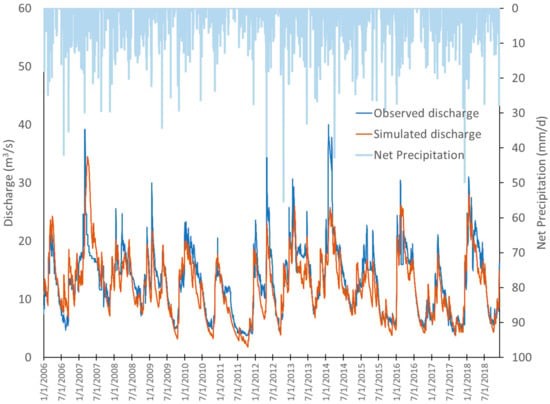
Figure 2.
Comparison between observed, simulated and natural discharge at the outlet of the Touvre karst aquifer over the entire period (month/day/year).
The variations in the levels of reservoir M reflect the variation in the annual stock and correspond to the filling and emptying of the matrix reservoir, which notably provides low water support (Figure 4). The variations of levels of the C reservoir give a good account of the transmissive behavior corresponding to the fast kinetics operating within the system. As already indicated in Duran et al. [30], the model allows to reproduce the multi-scale behavior of the aquifer. It is also interesting to a posteriori compare from a qualitative point of view the level variations in reservoirs M and C with the piezometric variations measured within the aquifer at the reference piezometers (Figure 5). A strong similarity can be observed with the variations of the piezometers (Amant for the Tardoire sub-catchment, Chazelles for the Bonnieure and Agris for the Touvre) dipping into the limestone formations of the watershed. The water levels simulated in reservoir M appear to be closely related to the piezometric water level observed in Chazelle piezometer. The delay observed between the two-time series may be related to the position of the Chazelle piezometer on top of the watershed, whereas the simulated piezometric level roughly corresponds to the response of the aquifer. The water level simulated in reservoir C appears to be closely related to the piezometric water level observed in Agris and Amant piezometers that are located in a fractured zone of the aquifer. The temporal variability of these piezometers allows identification of a high frequency component that corresponds to the rapid variation of the simulated water level in reservoir C. Therefore, the proposed model provides a good simulation of the observed discharge, particularly during low water periods. The internal functioning of the conceptual model, moreover, seems to be qualitatively in agreement with the field data.
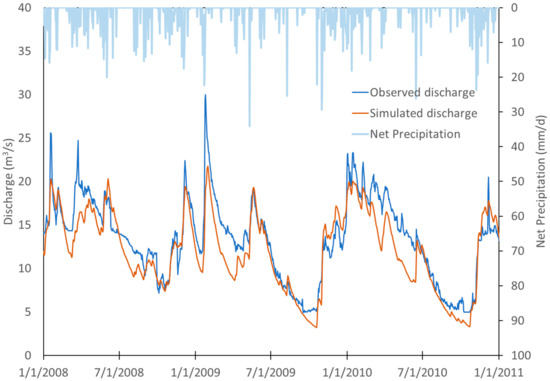
Figure 3.
Comparison between observed, simulated and natural discharge at the outlet of the Touvre karst aquifer over the 2008–2010 period (month/day/year).
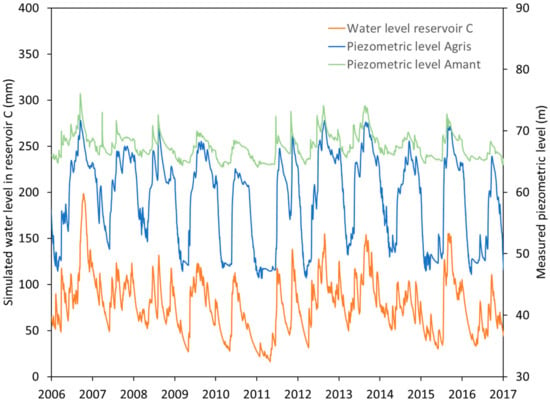
Figure 4.
Comparison between the water level in reservoir C and the piezometric level observed at Agris and Amant station.
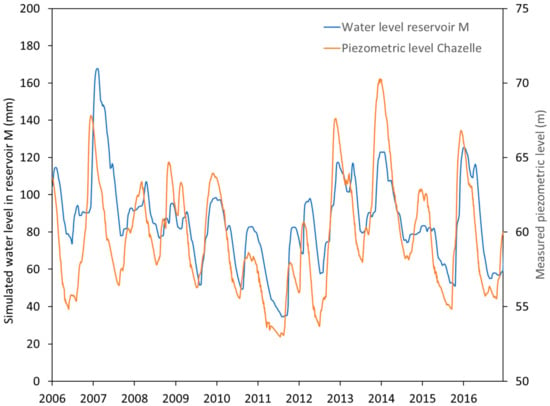
Figure 5.
Comparison between the water level in reservoir M and the piezometric level observed at Chazelle station.
4. Discussion
A quantitative estimate of the impact of the various withdrawals on the discharge at the Foulpougne station is proposed. This estimation was provided by removing all the withdrawals identified in the four watershed and by carrying out a new simulation using the set of optimized parameters from the first part of the study.
The impact of the withdrawals on the simulated runoff is directly related to their impact on the height of the conceptual reservoir, which is depicted in Figure 6 for the C and M reservoirs. During high water periods, agricultural withdrawals are null and domestic and industrial withdrawals have negligible impact. The most important impact corresponding to agricultural withdrawals is concentrated during low-water periods for both C and M reservoirs. The impact increases rapidly as soon as irrigation begins and the impact lasts a longer time in the matrix reservoir. The naturalization procedure diminishes the water level gradient between reservoirs M and C and thus strongly impacts the monthly mean of exchange flow between these two reservoirs (Figure 7). The impact of the withdrawals appears as concentrated on August to October, which is also consistent with the previous results.
In order to further quantify the impact of the naturalization procedure, the annual volume deficit that corresponds to the difference between simulated and natural discharge at the outlet of the watershed is depicted Figure 8.
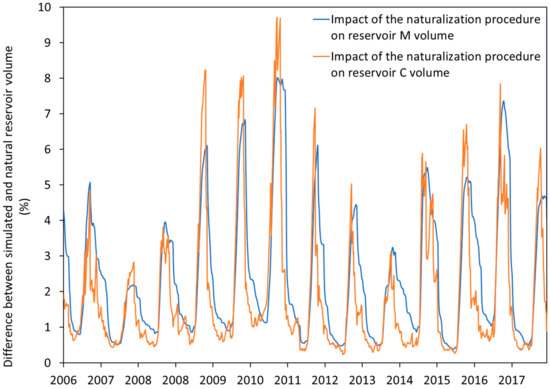
Figure 6.
Temporal variability of the impact of the naturalization procedure on the total daily water available in the conceptual reservoirs M and C of the calibrated model.
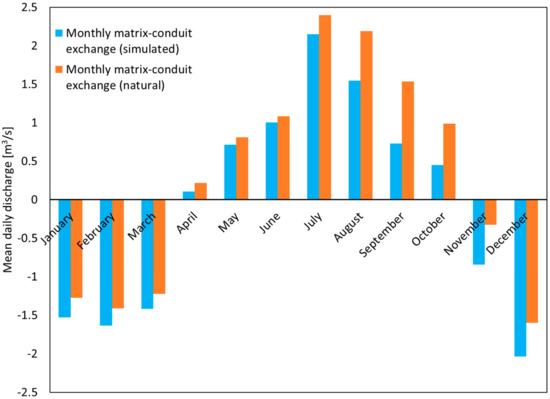
Figure 7.
Temporal variability of the impact of the naturalization procedure on the monthly mean matrix–conduit exchange of the calibrated model.
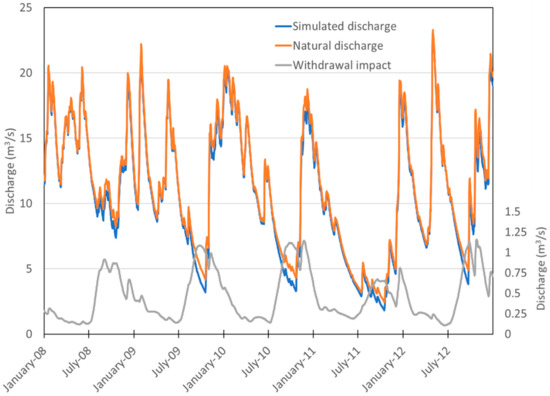
Figure 8.
Impact of the naturalization procedure on the discharge at the outlet of the system.
The annual volume deficits range between 1.2 and 1.8 Mm3 with significant annual correspondence to net rainfall and withdrawal fluctuations (Figure 9). The ratio of the impact defined as the ratio between natural and observed volume (always above 1 by construction) ranges from 1.025 up to 2.1 with a mean of 1.5. This ratio also highlights an inter-annual variability but appears as quite stationary between 2008 and 2016. We observed that the annual impact of the withdrawals over the simulated discharge is superior to the total withdrawals. This observation seems counterintuitive at first glance. However, it is the direct consequence of the naturalization impact on the exchange flow between M and C. Indeed, exchange flow is the key of the system’s ability to sustain a minimum discharge at the outlet in low flow periods. Another factor at stake is the non-linearity of exchange flow on the Touvre system and its high sensitivity to the difference in water levels between the matrix and conduit compartments, which is related to the high value of the optimized exponent for flow ( = 2.71).
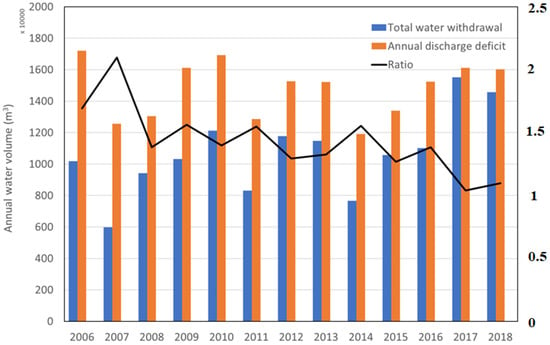
Figure 9.
Comparison between total water annual volume available at the Touvre karst spring outlet and the total water withdrawal over the four sub-catchments. The ratio between the two volumes is also shown in order to highlight a strong variability between these two water availability indexes based on our nonlinear model.
Several improvements are currently being explored, in particular with regard to better considering the spatialization of withdrawal data, but also better considering the variability of precipitation and especially evapotranspiration, which for watersheds with agricultural activities constitutes a significant forcing. Finally, this predictive model could also integrate, in the long term, a quantitative reflection on the combined impact of climate change and potential changes in agricultural practices on low water discharge in the years to come. This model, validated on the Touvre watershed, could also be applied to other karstic watersheds characterized by more inertial or more rapid behaviour and subject to different climates.
5. Conclusions
The drinking water supply on the Touvre watershed in the Charente is essential for the city of Angoulême. The impacts of withdrawals must be quantified since the Touvre is considered as a strategic reserve of regional interest. A conceptual model was built up to simulate the effects of withdrawals on a karstic aquifer.
The conceptual model with non-linear reservoirs has made it possible to simulate daily discharge in good statistical agreement with the discharge measured at the system outlet. The examination of the variation of the water levels of the two reservoirs C and M indicates a multi-scale temporal behavior consistent with the current knowledge on the behaviour of karst systems. Reservoir C corresponds well to the rapid response of the karst in relation to the infiltration of the two sub-catchments Tardoire and Bandiat and allows reproducing the floods of the system. Reservoir M corresponds to the slower recession dynamics of the matrix compartment in accordance with the piezometric data available on the karst watershed. The proposed methodology of naturalization of the discharge allowed proposing a quantification of the withdrawal (agricultural, industrial and domestic) impacts. Thus, the annual volume deficits are of the order of 1.5 Mm3 and the impact on the lower discharge is statistically of the order of 1 m3/s out of observed low-water flows of the order of 5 m3/s. We show that this deficit appears as related in the decrease of the simulated exchange flow between the two reservoirs C and M. The next step will be to provide quantification of coupled anthropogenic pressures and climate change projections on the water availability of karst systems.
Author Contributions
Conceptualization, D.L. and V.S.; methodology, D.L.; software, R.A. and V.S.; resources, D.L.; data curation, D.L., R.A. and V.S.; writing—original draft preparation, D.L.; writing—review and editing, N.M., C.O. and V.S. All authors have read and agreed to the published version of the manuscript.
Funding
This research was funded by SNO Karst INSU/CNRS.
Institutional Review Board Statement
Not applicable.
Informed Consent Statement
Not applicable.
Data Availability Statement
Not applicable.
Acknowledgments
The authors would like to thank the French Karst National Observatory Service (SNO KARST) initiative at the INSU/CNRS that aims to strengthen dissemination of knowledge and promotes cross-disciplinarily research on karst systems at the national scale, for their support on the use of the KarstMod model and for financial support of R.A internship. We are very grateful to the Agence de l’Eau Adour Garonne for providing water withdrawal data and to Meteo-France for providing hydro meteorological data.
Conflicts of Interest
The authors declare no conflict of interest.
References
- Ford, D.; Williams, P. Karst Hydrogeology and Geomorphology; John Wiley & Sons: Hoboken, NJ, USA, 2013; ISBN 978-0-470-84996-5. [Google Scholar]
- Chen, Z.; Auler, A.S.; Bakalowicz, M.; Drew, D.; Griger, F.; Hartmann, J.; Jiang, G.; Moosdorf, N.; Richts, A.; Stevanovic, Z.; et al. The World Karst Aquifer Mapping Project: Concept, Mapping Procedure and Map of Europe. Hydrogeol. J. 2017, 25, 771–785. [Google Scholar] [CrossRef] [Green Version]
- Goldscheider, N.; Chen, Z.; Auler, A.S.; Bakalowicz, M.; Broda, S.; Drew, D.; Hartmann, J.; Jiang, G.; Moosdorf, N.; Stevanovic, Z.; et al. Global of Carbonate Rocks and Karst Water Resources. Hydrogeol. J. 2020. [Google Scholar] [CrossRef] [Green Version]
- Jeannin, P.-Y.; Artigue, G.; Butscher, C.; Chang, Y.; Charlier, J.-B.; Duran, L.; Gill, L.; Hartmann, A.; Johannet, A.; Jourde, H.; et al. Karst Modelling Challenge 1: Results of Hydrological Modelling. J. Hydrol. 2021, 126508. [Google Scholar] [CrossRef]
- Ladouche, B.; Marechal, J.-C.; Dorfliger, N. Semi-Distributed Lumped Model of a Karst System under Active Management. J. Hydrol. 2014, 509, 215–230. [Google Scholar] [CrossRef] [Green Version]
- Charlier, J.-B.; Ladouche, B.; Maréchal, J.-C. Identifying the Impact of Climate and Anthropic Pressures on Karst Aquifers Using Wavelet Analysis. J. Hydrol. 2015, 523, 610–623. [Google Scholar] [CrossRef] [Green Version]
- Gutiérrez, F.; Parise, M.; De Waele, J.; Jourde, H. A Review on Natural and Human-Induced Geohazards and Impacts in Karst. Earth-Sci. Rev. 2014, 138, 61–88. [Google Scholar] [CrossRef]
- Hartmann, A.; Lange, J.; Vivó Aguado, À.; Mizyed, N.; Smiatek, G.; Kunstmann, H. A Multi-Model Approach for Improved Simulations of Future Water Availability at a Large Eastern Mediterranean Karst Spring. J. Hydrol. 2012, 468–469, 130–138. [Google Scholar] [CrossRef]
- Fiorillo, F.; Guadagno, F.M. Long Karst Spring Discharge Time Series and Droughts Occurrence in Southern Italy. Environ. Earth Sci. 2012, 65, 2273–2283. [Google Scholar] [CrossRef]
- Mazzilli, N.; Guinot, V.; Jourde, H.; Lecoq, N.; Labat, D.; Arfib, B.; Baudement, C.; Danquigny, C.; Dal Soglio, L.; Bertin, D. KarstMod: A Modelling Platform for Rainfall—Discharge Analysis and Modelling Dedicated to Karst Systems. Environ. Model. Softw. 2019, 122, 103927. [Google Scholar] [CrossRef] [Green Version]
- Baudement, C.; Arfib, B.; Mazzilli, N.; Jouves, J.; Lamarque, T.; Guglielmi, Y. Groundwater Management of a Highly Dynamic Karst by Assessing Baseflow and Quickflow with a Rainfall-Discharge Model (Dardennes Springs, SE France). Bull. Soc. Géol. Fr. 2017, 188, 40. [Google Scholar] [CrossRef]
- Sivelle, V.; Labat, D.; Mazzilli, N.; Massei, N.; Jourde, H. Dynamics of the Flow Exchanges between Matrix and Conduits in Karstified Watersheds at Multiple Temporal Scales. Water 2019, 11, 569. [Google Scholar] [CrossRef] [Green Version]
- Frank, S.; Goeppert, N.; Goldscheider, N. Improved Understanding of Dynamic Water and Mass Budgets of High-Alpine Karst Systems Obtained from Studying a Well-Defined Catchment Area. Hydrol. Process. 2021, 35, e14033. [Google Scholar] [CrossRef]
- Poulain, A.; Watlet, A.; Kaufmann, O.; Van Camp, M.; Jourde, H.; Mazzilli, N.; Rochez, G.; Deleu, R.; Quinif, Y.; Hallet, V. Assessment of Groundwater Recharge Processes through Karst Vadose Zone by Cave Percolation Monitoring. Hydrol. Process. 2018, 32, 2069–2083. [Google Scholar] [CrossRef]
- Bailly-Comte, V.; Martin, J.B.; Jourde, H.; Screaton, E.J.; Pistre, S.; Langston, A. Water Exchange and Pressure Transfer between Conduits and Matrix and Their Influence on Hydrodynamics of Two Karst Aquifers with Sinking Streams. J. Hydrol. 2010, 12, 55–66. [Google Scholar] [CrossRef]
- Bichot, F.; Thinon Larminach, M.; Touchard, F.; Bailly, D. Synthèse Hydrogéologique par Bassins Versants de la Région Poitou-Charentes—Relation Nappes-Rivières; BRGM Orléans: Orleans, France, 2005; 160p. [Google Scholar]
- Bichot, F.; Karnay, G.; Lavie, J. Les Sources de La Touvre: Synthèse Des Connaissances; BRGM Orléans: Orleans, France, 2003; 54p. [Google Scholar]
- Larocque, M.; Mangin, A.; Razack, M.; Banton, O. Contribution of Correlation and Spectral Analyses to the Regional Study of a Large Karst Aquifer (Charente, France). J. Hydrol. 1998, 205, 217–231. [Google Scholar] [CrossRef]
- Le Moine, N.; Andréassian, V.; Mathevet, T. Confronting Surface- and Groundwater Balances on the La Rochefoucauld-Touvre Karstic System (Charente, France). Water Resour. Res. 2008, 44. [Google Scholar] [CrossRef]
- Kurtulus, B.; Razack, M. Evaluation of the Ability of an Artificial Neural Network Model to Simulate the Input-Output Responses of a Large Karstic Aquifer: The La Rochefoucauld Aquifer (Charente, France). Hydrogeol. J. 2007, 15, 241–254. [Google Scholar] [CrossRef]
- Larocque, M.; Banton, O.; Ackerer, P.; Razack, M. Determining Karst Transmissivities with Inverse Modeling and an Equivalent Porous Media. Groundwater 1999, 37, 897–903. [Google Scholar] [CrossRef]
- Larocque, M.; Banton, O.; Razack, M. Transient-State History Matching of a Karst Aquifer Ground Water Flow Model. Groundwater 2000, 38, 939–946. [Google Scholar] [CrossRef]
- Oudin, L.; Hervieu, F.; Michel, C.; Perrin, C.; Andréassian, V.; Anctil, F.; Loumagne, C. Which Potential Evapotranspiration Input for a Lumped Rainfall–Runoff Model? J. Hydrol. 2005, 303, 290–306. [Google Scholar] [CrossRef]
- Allen, R.G.; Pereira, L.S.; Raes, D.; Smith, M. Crop Evapotranspiration—Guidelines for Computing Crop Water Requirements—FAO Irrigation and Drainage Paper 56; FAO: Rome, Italy, 1998; Volume 300, p. D05109. [Google Scholar]
- Jourde, H.; Lafare, A.; Mazzilli, N.; Belaud, G.; Neppel, L.; Dörfliger, N.; Cernesson, F. Flash Flood Mitigation as a Positive Consequence of Anthropogenic Forcing on the Groundwater Resource in a Karst Catchment. Environ. Earth Sci. 2014, 71, 573–583. [Google Scholar] [CrossRef] [Green Version]
- Sivelle, V.; Jourde, H.; Bittner, D.; Mazzilli, N.; Tramblay, Y. Assessment of the Relative Impacts of Climate Changes and Anthropogenic Forcing on Spring Discharge of a Mediterranean Karst System. J. Hydrol. 2021, 598, 126396. [Google Scholar] [CrossRef]
- Water & Environment Design Office; (Bureau D’études eau & environnement). Hydrological Simulation Model, PGE Charente Model Applied to the Touvre. Methodological Note. Personal communication, 2015.
- Nash, J.E.; Sutcliffe, J.V. River Flow Forecasting through Conceptual Models Part I—A Discussion of Principles. J. Hydrol. 1970, 10, 282–290. [Google Scholar] [CrossRef]
- Pool, S.; Vis, M.; Seibert, J. Evaluating Model Performance: Towards a Non-Parametric Variant of the Kling-Gupta Efficiency. Hydrol. Sci. J. 2018, 63, 1941–1953. [Google Scholar] [CrossRef]
- Duran, L.; Massei, N.; Lecoq, N.; Fournier, M.; Labat, D. Analyzing Multi-Scale Hydrodynamic Processes in Karst with a Coupled Conceptual Modeling and Signal Decomposition Approach. J. Hydrol. 2020, 583, 124625. [Google Scholar] [CrossRef]
Publisher’s Note: MDPI stays neutral with regard to jurisdictional claims in published maps and institutional affiliations. |
© 2022 by the authors. Licensee MDPI, Basel, Switzerland. This article is an open access article distributed under the terms and conditions of the Creative Commons Attribution (CC BY) license (https://creativecommons.org/licenses/by/4.0/).